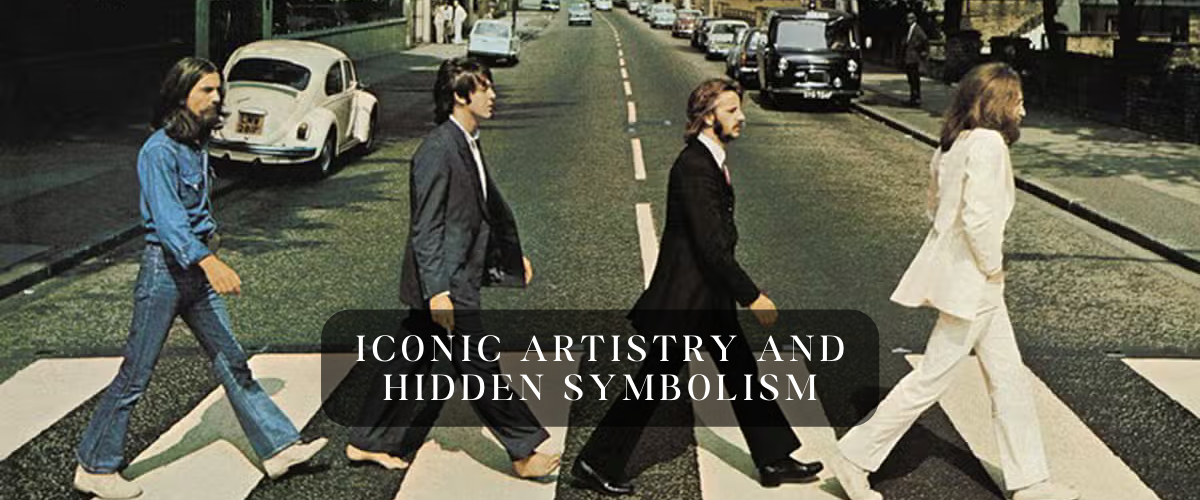Iconic Artistry And Hidden Symbolism-The Beatles’ Abbey Road Album Cover

When it comes to iconic album covers, few can rival the enduring fascination and cultural impact of The Beatles’ ‘Abbey Road’. Released in 1969, this album’s cover image, featuring John Lennon, Paul McCartney, George Harrison and Ringo Starr strolling across a zebra crossing outside Abbey Road Studios, has become an indelible part of music history. Beyond its striking visual appeal, the album cover is a treasure trove of hidden symbolism, conspiracy theories and artistic brilliance. Let’s explore the making of the Abbey Road album cover and delve into the layers of meaning that have made it an enduring piece of pop culture.
Image Courtesy: Britannica
The Making of Abbey Road Album Cover
The iconic album cover for ‘Abbey Road’ was the brainchild of photographer Iain Macmillan. On August 8, 1969, Macmillan stood on a stepladder in the middle of the road and captured the legendary image in just six quick shots. The decision to shoot outside Abbey Road Studios (formerly known as EMI Studios) was a nod to the band’s recording home, and the simplicity of the image was intended to reflect the straightforward nature of the music within the album.
The Symbolism of Abbey Road
Upon closer examination, the Abbey Road album cover reveals a host of hidden symbols and clues. Some of the most notable include:
Clothing Choices: The Beatles’ attire on the cover has sparked considerable speculation. Some fans have suggested that their outfits represent funeral attire, with John Lennon in white symbolizing the clergy, Ringo Starr in black signifying the undertaker, George Harrison in denim representing the gravedigger, and Paul McCartney barefoot and out of step signifying a corpse.
Also read: Unravelling the Enigma: Mysteries and Controversies in the World of Music
The White Volkswagen Beetle: The presence of a white Volkswagen Beetle in the background has intrigued many. Some have suggested that it symbolizes the famous ‘Paul is dead’ conspiracy theory, with ‘LMW 28IF’ on the license plate hinting at McCartney’s age if he had lived (supposedly 28 years old) and ‘IF’ suggesting an alternative reality.
Image Courtesy: SEBeetles.com
The Cigarette: Paul McCartney’s left-handed cigarette hold on the cover was taken as a clue by those who believed in the ‘Paul is dead’ rumour. However, McCartney has stated that he was simply holding the cigarette this way because it was raining, and he didn’t want to get it wet.
Also read: Unravelling The Most Famous Music Conspiracy Theories
Image Courtesy: Ultimate Classic Rock
Cultural Impact and Parodies
The Abbey Road album cover has had a profound cultural impact. It has been parodied countless times, with artists, celebrities and fans recreating the iconic image in various humourous and creative ways. The zebra crossing itself, located on Abbey Road in London, has become a tourist attraction, and fans from around the world visit the spot to pay homage to the Beatles.
Image Courtesy: WallpaperBetter
Paul-is-Dead Rumours and Urban Legends
The ‘Paul is dead’ conspiracy theory, which gained traction in the late 1960s, was fuelled in part by clues perceived in the Abbey Road album cover. While the theory has been widely debunked, it remains a fascinating chapter in Beatles lore and a testament to the power of symbolism in popular culture.
Image Courtesy: British GQ
The Beatles’ Abbey Road album cover is a masterpiece of simplicity and hidden meaning. It has transcended its role as a mere album cover to become a symbol of artistic genius and cultural significance. Whether you see it as a cleverly constructed work of art or a canvas for conspiracy theories, there’s no denying that Abbey Road’s cover remains an iconic piece of visual history, forever intertwined with the magic of the Fab Four’s music.
–Silviya.Y








